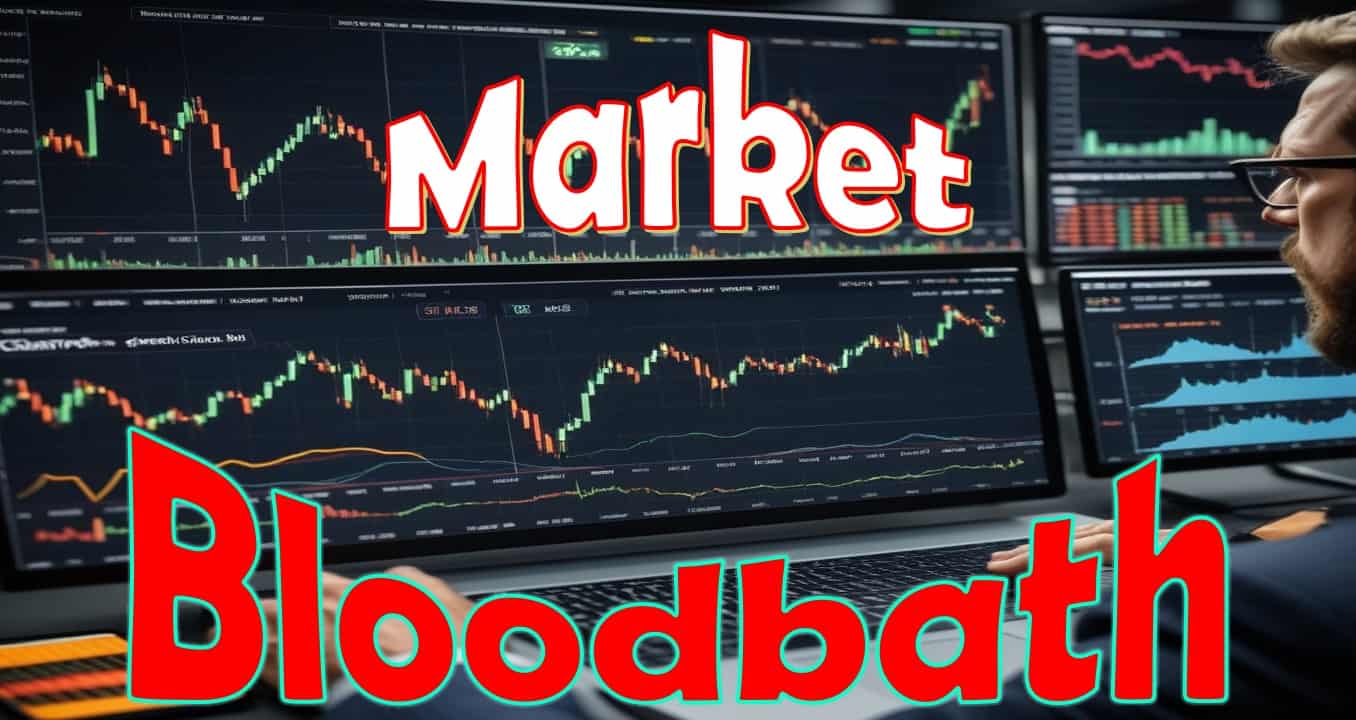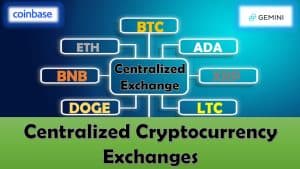
Decentralized Cryptocurrency Exchanges: The Future of Crypto
Last updated on June 8th, 2023 at 02:39 pm
Picture this… you’re deep in the crypto jungle, surrounded by digital beasts that roar “Bull” or “Bear” as they sprint past.
You’re trying to navigate your way through the tangled vines of centralized exchanges, with their hefty fees and susceptibility to hacks.
Suddenly, a ray of light pierces through the thick foliage… an oasis of decentralized cryptocurrency exchanges emerges on the horizon!
Welcome, fearless explorer, to the future of crypto and finance.
Decentralized Cryptocurrency Exchange (DEX) is a type of crypto trading platform that operates without relying on an intermediary to facilitate transactions. DEXs operate on a blockchain and employ smart contracts, ensuring that no single entity has control over the platform or user funds. DEXs create liquidity with an Automated Market Maker (AMM) model. Liquidity providers deposit assets into a pool, and traders swap their tokens directly with the pool’s reserves. DEXs are accessed via a cryptocurrency wallet connected to the exchange.
As we continue, we’ll dive headfirst into the world of DEXs, leaving behind the murky waters of their centralized counterparts.
We’ll explore how these platforms are leveling up the crypto game by offering users increased security, privacy, and control over their digital assets.
But hold onto your private keys, we’ll also delve into the nitty-gritty details of why DEXs are slowly but surely becoming the go-to choice for crypto enthusiasts worldwide.
So, strap on your metaphorical hiking boots, and let’s uncover the future of the crypto industry together.
Decoding DEXs
- What Are Cryptocurrency Exchanges?
- Decentralization: The Heart of Rebellion
- How DEXs Work
- Liquidity: The Lifeblood of a DEX
- Interacting With a DEX
- DEX Role in Mass Adoption
- Effect of DEXs on Institutional Adoption
- DEX Advantages & Disadvantages
- DEX Participation
- DEX Options
- DEX Regulatory Concerns
- DEXs: Embrace the Future
- Frequently Asked Questions (FAQ)
What Are Cryptocurrency Exchanges?
Cryptocurrency exchanges are digital platforms that allow users to buy, sell, and trade cryptocurrencies. They are typically used to exchange fiat currency (e.g. USD) for a cryptocurrency of choice, and also provide the ability to swap one type of crypto coin or token for another.
Generally speaking there are two types of cryptocurrency exchanges: centralized and decentralized.
Centralized Exchanges
Centralized Exchanges (CEX) are traditional online platforms that offer digital asset transactions.
Centralized exchanges require the user to deposit their funds into a custodial wallet, over which the exchange holds full control. The exchange may also impose limits on how much crypto you can withdraw or deposit.
Additionally, CEXs collect personal information from users and are thus subject to government regulation.
Centralized exchanges generally have a more user-friendly interface, making buying and selling cryptocurrencies more straightforward.
CEXs are currently an important part of the cryptocurrency landscape, as such, you should take a few minutes to review the article I’ve written about them.
Decentralized Exchanges
Though we’re about to delve deep into DEXs in the article, I would like to take a minute to outline what they are.
Decentralized Exchanges (DEXs), are digital asset trading platforms that operate without relying on a central authority. DEXs utilize smart contracts and operate on a blockchain to ensure that no single entity has control over the platform or its users’ funds.
Additionally, DEXs often offer users additional privacy as they do not require personal information to be shared with the exchange. DEXs may lack the same level of liquidity and functionality as centralized exchanges but offer far more security for traders.
Now that we have a basic understanding of what crypto exchanges are, let’s get into the nitty-gritty of DEXs.
Decentralization: The Heart of Rebellion
Picture this… you’re at a party, and everyone’s talking about the latest buzzword in town… cryptocurrency.
You nod along, pretending to understand, but deep down, you’re still trying to figure out how to trade these digital assets without getting lost in the Matrix.
Well, fear not…
I’ll be your Morpheus, guiding you through the world of decentralized exchanges, where you can trade your crypto like a pro without ever having to worry about Agent Smith (or central authorities).
Decentralized cryptocurrency exchanges, DEXs, give you the ability to trade your digital assets with ease, bypassing the pesky middlemen found in centralized exchanges.
Unlike their centralized counterparts, which act as gatekeepers to your funds, DEXs give you complete control over your crypto destiny. And, thanks to DEXs you can say goodbye to hefty fees and giving up your anonymity.
As we venture deeper into our exploration, we’ll uncover the magic behind these decentralized platforms, learn how they use cutting-edge technology to facilitate seamless trading, discover why they’re all the rage and their future in the crypto universe.
So buckle up, and let’s dive into the world of DEXs.
How DEXs Work
At the core of every DEX lies the spirit of decentralization. DEXs operate without a central authority, eliminating the need for intermediaries. This means no more surrendering control of your private keys (aka your digital assets) to unknown entities.
Instead, DEXs allow for peer-to-peer trading, empowering users to take control of their own crypto destiny.
But how exactly do DEXs differ from centralized exchanges (CEXs)?
Well, imagine CEXs as a traditional bank, where you deposit your funds and trust them with your life savings… hopefully that made you feel a pit in your stomach!
Afterall, given some of the recent banks failures, your life savings is certainly not safe there!
On the other hand, with a DEX, you’re the master of your own money and savings, retaining full control over your private keys and assets.
This autonomy translates to enhanced security, privacy, and the satisfaction of knowing you are not at the whim of anyone else.
Liquidity: The Lifeblood of a DEX
Every exchange, especially a DEX, requires liquidity to function effectively.
DEXs accomplish this primarily with Automated Market Makers (AMMs) and liquidity pools, which enable users to swap tokens directly with the reserves held in smart contracts.
This groundbreaking mechanism ensures that DEXs can offer competitive trading rates and a smooth trading experience for all users.
Though some DEXs utilize the traditional Order Book method or the DEX Aggregator method of providing liquidity, these are definitely not the primary or best methods for these blockchain based financial platforms.
Order Book Liquidity
This method puts both buy and sell orders placed on a platform by traders in a single place. Traders use the order book to determine market depth (aka the pool of eligible orders) and assess the demand from both buyers and sellers.
By analyzing the order book, traders can identify entry and exit points, helping them make informed decisions and maximize potential returns.
The order book method can be a great tool for traders when used in the right context, such as the traditional financial system (TradFi). It does so by providing an insight into market depth and allowing traders to make informed decisions, helping to maximize potential returns.
However, it is not the most efficient or secure way of achieving liquidity on decentralized exchanges.
DEX Aggregator Method
A DEX aggregator works by collecting data from multiple sources and then displaying it in an easy-to-read format.
Data included are things like order books, liquidity, fees, and other information about each exchange. This data is used to match orders across different DEXs and find the best price for the user.
The aggregator will also show you how much liquidity is available on each exchange so you can make sure there are enough buyers or sellers to complete your order.
Another key aspect of a DEX aggregator is its ability to provide price discovery. This means that it can help traders find out what the current market price of an asset is on different exchanges so they can make informed decisions when trading.
While a DEX aggregator is an invaluable tool for anyone looking to trade cryptocurrencies on decentralized exchanges, it is currently not the most popular method for providing liquidity.
Automated Market Makers (AMM) Method
Automated Market Makers (AMMs) are decentralized protocols that facilitate trading digital assets in a decentralized exchange (DEX) without relying on order books or traditional market makers. Instead, they use mathematical algorithms to determine asset prices and execute trades.
The core mechanism behind AMMs is token swapping, which enables users to exchange one token for another directly from a liquidity pool.
When a user initiates a swap, the AMM’s algorithm calculates the price of the traded tokens based on the current supply and demand in the pool.
Once the price is determined, the trade is executed by the smart contract, which adjusts the pool’s reserves accordingly. This process ensures that the liquidity pool remains balanced, even as trades occur.
Still want to know more about AMMs?
No problem, delve deeper into automated market makers here.
But, how important are smart contracts with respect to a DEX?
Smart Contracts
At the heart of every AMM lies smart contracts, self-executing agreements with the terms of the contract directly written into code.
Smart contracts, at their core, are self-executing digital agreements that use blockchain technology to execute the terms of the contract.
They remain stored in a secure ledger and can be used for a variety of purposes, including transferring assets, exchanging currency, managing joint ventures, and much more.
Smart contracts automate trust by eliminating the need for costly and time-consuming paperwork, making them an incredibly powerful tool for businesses.
Furthermore, smart contracts are immutable. Once they are recorded on the blockchain they cannot be altered or deleted, providing a secure way to fulfill contractual obligations.
Smart contracts enable DEXs to provide a trustless and permissionless environment that is also highly efficient and cost-effective. This makes DEXs a great choice for traders who want to take control of their trades, allowing them to maximize profits while also ensuring that they are not at the whim of anyone else.
But smart contracts have many more use cases and potential functionality. Explore more about smart contracts here.
In the context of AMMs, these smart contracts govern the rules for trading, pricing, and managing liquidity pools.
Liquidity Pool
We started our journey in this article by entering the crypto jungle, and later on I promised to be your Morpheus so you didn’t get lost in the Matrix.
So, to help me keep my promises, let me try to use some other interesting metaphors to help you understand the ins and outs of liquidity pools.
Think of a liquidity pool as a giant bowl filled with lemonade… I mean full of digital assets.
It’s a huge reservoir of tokens locked in a smart contract, just waiting for traders to come and take a sip (or, you know, exchange their digital assets).
Whenever someone wants to buy or sell an asset, they take from or add to the bowl’s contents. This makes sure that everyone can find what they’re looking for, and ensures that the market remains liquid and efficient.
Ultimately, these pools are the lifeblood of DEXs. They make sure that there’s always enough “lemonade” for everyone to enjoy.
Liquidity pools are not just a bunch of lemons… squeeze more out of liquidity pools here.
But, who’s responsible for keeping this bowl full?
Liquidity Providers
Liquidity Providers (LPs), the unsung heroes of crypto trading on DEXs.
Just like proud parents manning the lemonade stand, LPs supply the necessary ingredients (tokens) to keep the stand going.
They do this by depositing equal values of two tokens into the pool, creating a market for traders to buy and sell.
So, why would someone do this?
Well, just like kids earning a few extra bucks at their lemonade stand, LPs can generate revenue from their participation.
Every time someone takes a sip (i.e., makes a trade), they pay a small fee. These fees are then distributed among the LPs, proportionate to their share of the pool.
As with any entrepreneurial venture, being a liquidity provider comes with its fair share of risks and rewards.
As I mentioned, on the plus side, LPs can earn a passive income from trading fees, which can be quite lucrative in high-volume markets.
It’s like having a lemonade stand on a scorching hot day, everyone wants a piece of the action!
However, there’s also the risk of “impermanent loss,” a fancy term for the potential reduction in value when the prices of the deposited assets change relative to each other.
Think of it as accidentally mixing up your lemonade with grapefruit juice, the result might not be as sweet as you’d hoped.
Now that you understand liquidity pools, let’s look at how to use a DEX to start trading.
Interacting With a DEX
Using a DEX is relatively straightforward, as long as you have the necessary crypto wallets set up. All that’s needed to start trading is to connect your wallet and deposit the assets you’d like to trade into the exchange.
One of the most popular wallets that is used to access a DEX is MetaMask.
MetaMask is a popular browser-based Ethereum wallet that allows users to access decentralized applications (DApps) safely and securely. With MetaMask you can also use it to access other blockchains such as Binance Smart Chain and Polygon.
To get started, head over to the MetaMask website and download the browser extension. Once installed, you can create an account and connect it to your DEX of choice.
Once you’re all set up, simply use the search bar on the exchange’s homepage to find the pair that you’d like to trade.
Most DEXs will provide basic order types, such as limit and market orders. You can use these to buy or sell your chosen asset based on the current price or a price set in advance.
In addition to enabling efficient trading, DEXs have the potential to revolutionize crypto adoption by making digital assets more accessible.
DEX Role in Mass Adoption
At the onset of the crypto revolution, centralized exchanges (CEXs) were the dominant players, offering a convenient, and user-friendly gateway to trade various digital assets.
They provided the much-needed infrastructure for newcomers to enter the world of cryptocurrencies. However, despite their initial popularity, centralized exchanges had their fair share of drawbacks.
The primary concern with CEXs lies in their centralized nature, which requires users to trust them with their funds and personal data. This centralization has made them prime targets for hackers, leading to numerous high-profile security breaches and thefts over the years.
This history has made decentralized exchanges extremely important and necessary for the future of cryptocurrency.
The importance of DEXs in facilitating mass adoption of cryptocurrencies cannot be overstated. By providing a more secure and transparent alternative to centralized platforms, they help build trust among potential users, encouraging more people to enter the crypto space.
Moreover, decentralized exchanges promote the core principles of cryptocurrencies… decentralization, autonomy, and privacy.
As more users recognize and appreciate these values, the demand for DEXs is likely to grow, further propelling the mass adoption of digital assets.
Ultimately, decentralized exchanges are not only essential to the survival of the cryptocurrency ecosystem, but also play a crucial role in driving its widespread adoption.
By offering a secure, transparent, and trustless environment for trading digital assets and accessing the ever evolving levels of financial services, DEXs pave the way for a more inclusive and accessible financial future.
The world is moving toward embracing decentralized finance, expect decentralized exchanges to continue leading the charge, shaping the future of the cryptocurrency landscape and empowering individuals with greater control over their financial destiny.
As decentralized exchanges become more popular, they are also getting the attention of institutional investors, large corporations and TradFi.
Effect of DEXs on Institutional Adoption
While DEXs offer many benefits to individual investors, their impact on institutional adoption of cryptocurrency remains a topic of debate.
The appeal of decentralized exchanges lies in their enhanced security and transparency. With no central authority, user privacy and control over assets are prioritized.
However, the drawbacks of DEXs may deter institutional traders. In particular, the potential for lower liquidity and the lack of regulation may discourage some institutional traders from entering the market.
This lack of regulatory clarity is probably the greatest challenge that will face institutional entities thanks to DEXs. This is why institutional investors are currently looking to utilize centralized exchanges. The transition to decentralized exchanges may require a significant shift in mindset and investment strategy.
Despite these challenges, there are also several opportunities for Bitcoin and other cryptocurrencies on DEXs.
Firstly, DEXs can provide access to more decentralized cryptocurrencies that formerly were not traded on centralized exchanges.
Secondly, by leveraging decentralized finance (DeFi) protocols, decentralized exchanges can offer more advanced trading options, such as margin trading and derivatives.
DEXs may represent a novel opportunity for institutional adoption of cryptocurrency.
The advantages of security, transparency, liquidity, and cost-effectiveness offered by decentralized exchanges can appeal to institutional traders, combined with the access to more decentralized cryptocurrencies and the advanced trading options DeFi protocols provide.
But, like everything else, decentralized exchanges have both pros and cons. Let’s explore both sides of this decentralized coin.
DEX Advantages & Disadvantages
Decentralized exchanges have emerged and continued to grow as a popular alternative to centralized exchanges.
This is due to the numerous advantages that DEXs provide. These include enhanced security, transparency, and cost-effectiveness.
However, DEXs also present certain drawbacks such as lower liquidity and a lack of regulation.
| Advantages | Disadvantages |
|---|---|
| Anonymity | Liquidity |
| Decentralized | Learning Curve |
| Non-Custodial | Smart Contract & Bridge Vulnerability |
| Permissionless | Unvetted Token Listings |
| Transparent | Limited Exchange Features |
| Censorship Resistant | Slower Transaction Speeds |
| Token Variety | High Gas Fees |
| Reduced Security Risks | Lack of Regulatory Clarity |
| Reduced Counterparty Risk | Limited or No Customer Support |
| Reduced Trading Fees |
Despite the pros and cons of DEXs, they offer and additional opportunity for crypto enthusiasts.
DEX Participation
DEXs also offer you and I the opportunity to help the platform and create an almost passive income for doing so. You can join a liquidity pool and become a liquidity provider.
Liquidity providers deposit tokens into a smart contract in exchange for a proportional share of fees generated by trades in the pool. The tokens are then used to create a market for trading and to facilitate transactions more efficiently by reducing price slippage.
Being a liquidity provider is a critical function within the decentralized finance (DeFi) ecosystem as it enhances the efficiency and liquidity of markets. Liquidity providers act as market makers, ensuring that instant swaps can happen at any time.
How To Be a Liquidity Provider
To become a liquidity provider, the first step is to identify which DEX platform aligns with your interests.
Some of the popular DEX platforms include Uniswap, SushiSwap, and Curve Finance. Each platform has its unique liquidity provision model, which requires different tokens and fees.
Secondly, it’s essential to have liquidity to invest in the platform. For instance, to participate in Uniswap, liquidity providers contribute an equivalent ratio of two tokens, such as Ethereum and a stablecoin.
After investing funds, you need to add liquidity to a liquidity pool by depositing an equal amount of both tokens in a smart contract controlled by the protocol.
Once a transaction is completed, the liquidity provider receives “liquidity tokens” that represent the proportional share of the liquidity pool.
To begin, it’s necessary to approve the smart contract that manages the liquidity pool. This step is vital as it guarantees that the funds are locked into the contract until the liquidity provider decides to remove liquidity from the pool.
Liquidity Provider Earning Potential
Liquidity providers earn rewards and incentives in the form of trading fees and liquidity provider rewards (token rewards) for providing liquidity to the market.
The fees and rewards vary from platform to platform, but generally, a portion of the trading fees goes to the liquidity providers as a reward for providing liquidity.
The return on investment for liquidity providers depends on several factors, including the amount of liquidity they provide, the trading frequency, and the market’s volatility.
For the most profitable liquidity pools, liquidity providers can earn anywhere from 10% to 20% annually.
In addition, liquidity providers may also earn through liquidity mining, a mechanism used by some DEX platforms to incentivize liquidity providers.
Liquidity mining involves rewarding LPs with additional tokens in exchange for providing liquidity to the platform. These tokens may increase in value, which results in additional earnings for the liquidity providers.
Liquidity Provider Risks
While providing liquidity can be lucrative, there are risks involved. Two of the most significant risks are price slippage and impermanent loss.
Price slippage occurs when the market moves in a short span, and the prices change dramatically before trades execute, leading to a less favorable trading price.
Impermanent loss occurs when the market moves significantly, resulting in a deviation from the original ratio of tokens that the liquidity provider contributed. This impermanent loss happens when the liquidity provider removes their liquidity from the pool.
The question of becoming a liquidity provider comes down to one question: are the rewards you’re going to earn worth the potential risks?
Providing liquidity has become a lucrative investment option that requires minimal effort and expertise.
With careful investment selection, research, and proper risk management, becoming a liquidity provider can generate additional income and a solid income stream.
What are your current options for decentralized crypto exchanges?
DEX Options
As of the writing of this article, the following DEXs are among the largest in the space.
UniSwap
UniSwap is a DEX based on the Ethereum blockchain. It allows users to swap ERC-20 tokens. UniSwap uses an automated market-making system, which means that users trade against a liquidity pool rather than against other traders.
The platform charges a 0.3% trading fee, with 0.25% going to liquidity providers and 0.05% going to the protocol treasury. UniSwap’s unique feature is its ability to provide liquidity for almost any ERC-20 token. It has a user-friendly interface, and users can access it via a web browser or a mobile app.
In terms of liquidity, UniSwap has the highest trading volume of all decentralized exchanges, with a total trading volume of over $25 billion.
PancakeSwap
PancakeSwap is built on the Binance Smart Chain. It allows users to swap BEP-20 tokens. PancakeSwap uses an automated market-making system like UniSwap, and it charges a 0.2% trading fee with 0.17% going to liquidity providers and 0.03% going to the platform’s own token, CAKE.
PancakeSwap’s unique feature is its ability to provide liquidity for smaller market cap tokens, which may not be available on other exchanges. It has a user-friendly interface, and users can access it via a web browser or a mobile app.
PancakeSwap’s trading volume has been consistently high, with a total trading volume of over $10 billion.
SushiSwap
SushiSwap is built on the Ethereum blockchain. It offers the same features as UniSwap, such as the ability to swap ERC-20 tokens and provides liquidity using an automated market-making system.
SushiSwap also charges a 0.3% trading fee, with 0.25% going to liquidity providers and 0.05% going to the SushiSwap Treasury.
However, SushiSwap’s unique feature is its reward system for liquidity providers, where they earn additional SUSHI tokens. It has a user-friendly interface, and users can access it via a web browser or a mobile app.
SushiSwap’s trading volume has been steadily increasing, with a total trading volume of over $16 billion.
Balancer
Balancer is a decentralized exchange built on the Ethereum blockchain. It offers liquidity pools that allow anyone to become a liquidity provider.
Balancer’s unique feature is that it allows users to create custom pools with more than two tokens.
Balancer charges a 0.3% trading fee, with 0.05% going to liquidity providers and 0.25% being split between the protocol treasury and BAL token holders. Balancer has a user-friendly interface, and users can access it via a web browser or a mobile app.
Balancer’s trading volume has been steadily increasing, with a total trading volume of over $2 billion.
Curve
Curve is built on the Ethereum blockchain. It is designed to provide low slippage trading for stablecoins.
Curve’s unique feature is its use of an algorithmic market-making system, which allows for low slippage swaps of stablecoins. Curve charges a 0.04% trading fee, with 0.02% going to liquidity providers, and 0.02% being burned.
Curve has a user-friendly interface, and users can access it via a web browser or a mobile app.
Curve’s trading volume has been consistently high, with a total trading volume of over $13 billion.
Cross Comparison
In terms of trading fees, all exchanges charge a similar percentage, ranging from 0.2% to 0.3%.
UniSwap has the highest trading volume, followed by SushiSwap, PancakeSwap, Curve, and Balancer.
In terms of user interface, all exchanges have a user-friendly interface, accessible via a web browser or a mobile app.
Regarding liquidity, UniSwap has the highest liquidity and offers the most trading pairs, followed by SushiSwap, PancakeSwap, Curve, and Balancer.
In terms of token options, UniSwap and SushiSwap have the most diverse selection of ERC-20 tokens. PancakeSwap has a wide selection of BEP-20 tokens, while Balancer and Curve are more narrowly focused on specific markets.
Popularity-wise, UniSwap remains the most popular due to its high liquidity and trading volume, followed by SushiSwap and PancakeSwap. Curve and Balancer are relatively newer and have smaller trading volumes.
All five exchanges have shown solid performance, with returns ranging from a few percent to over 100% for liquidity providers.
Given the potential returns and usability of decentralized exchanges, it is important to consider the regulatory concerns that surround them.
DEX Regulatory Concerns
The decentralized nature of these exchanges makes regulatory compliance challenging, due to the lack of a centralized authority.
As a result, governments face significant regulatory challenges in trying to oversee DEXs, especially regarding decentralized governance, liquidity, and trading principles.
Different Approaches to Regulation
Different regions and countries have taken different approaches to regulate DEXs.
In the United States, the Securities and Exchange Commission (SEC) has been critical of DEXs. The SEC has highlighted that DEXs operating as marketplaces for the trading of security tokens must comply with applicable securities laws and regulations.
In Europe, regulatory approaches to DEXs vary among member states. Some countries have embraced DEXs, while others have maintained strict regulatory control over them.
In Asia, several countries like China, India, and Singapore have taken a cautious approach to DEXs. Chinese regulators, for example, have recently banned financial institutions and payment companies from providing services related to cryptocurrencies.
Regulatory Challenges
Firstly, regulatory agencies are struggling with decentralized governance, which is a significant challenge that poses the question of where responsibility and accountability stop and start.
For example, if there is an issue with the DEX, such as security breaches or fraudulent activities, it can be hard to determine the responsible entity.
Secondly, regulation of liquidity poses a challenge, as liquidity on DEXs is not always feasible, resulting in the potential for market manipulation and volatility. Authorities could use market surveillance to mitigate this risk, but this activity could invade user privacy.
Thirdly, trading principles are another regulatory challenge as trades on DEXs happen without intermediaries and in real-time enforcement of trade confirmation, recordkeeping becomes tricky.
Potential Solutions
One potential solution to address the regulatory challenges is for DEXs to implement a hybrid governance model.
This model would involve a combination of decentralized and centralized governance, with the operations being decentralized, while regulatory compliance would be centralized.
Even though it fly’s in the face of the foundational tenets of cryptocurrency, DEXs could cooperate with regulators and authorities in implementing KYC and AML procedures and policies to protect user information and prevent illegal activities.
Regulatory challenges associated with DEXs are significant and complex. Regulatory authorities are grappling with the decentralized nature of exchanges as there is no clear entity to hold accountable, and trading principles play out in real-time.
DEXs: Embrace the Future

The future of decentralized exchanges (DEXs) is very promising, considering the advancements in blockchain technology, the explosive growth of decentralized finance (DeFi), and the increasing user preference for more secure and transparent trading platforms.
Advancements in blockchain technology, including scalability, interoperability, and privacy, are expected to significantly boost the growth of DEXs.
Additionally, greater acceptance and popularization of blockchain technology will enable more efficient cross-border transfers of funds, increasing the potential for growth of DEXs across the globe.
One of the highlighted risks of investing in DEXs is their relatively low liquidity pools. However, several technological advancements are expected to make liquidity provision more accessible, which will reduce this risk and continue to advance the growth of DEXs.
Moreover, the widespread adoption of decentralized exchanges could spark the development of completely new financial applications and investment instruments, further advancing the evolution of the financial market.
Another key opportunity in the evolution of DEXs is the enhancement of DeFi services, such as borrowing and lending, staking, and yield farming, which will usher in even more users into DEXs.
In conclusion, the future of DEXs is indeed bright, and with the ongoing advancement in technology and user preference, DEXs will continue to grow and mature in the coming years.
These changes will revolutionize the traditional financial industry and spur innovation across the esoteric world, ultimately yielding more diverse financial services for people worldwide.
Frequently Asked Questions (FAQ)
Q: What is a decentralized exchange (DEX)?
A: A decentralized exchange (DEX) is a cryptocurrency trading platform that does not rely on a third-party service to hold user funds. Instead, it allows users to directly interact with one another in order to trade digital assets and cryptocurrencies without the need for an intermediary.
Q: What are the benefits of using a DEX?
A: The primary benefit of using a DEX is that it offers users more control over their funds, as they do not need to trust the platform with their private keys. Additionally, due to its decentralized nature, DEXs tend to offer lower fees and faster transaction times compared to traditional exchanges.
Q: What are the risks associated with DEXs?
A: The main risk associated with DEXs is their relatively low liquidity pools, which can make it difficult to fill large orders without impacting the market price.
Q: Are DEXs regulated?
A: Most DEXs are not currently regulated by financial authorities, however this could potentially change in the future as the industry matures.
Q: Are there any alternatives to DEXs?
A: Yes, although many prefer the security and decentralization of DEXs, there are also several centralized exchanges available for trading cryptocurrencies.
Disclaimer
The information provided here is for INFORMATIONAL & EDUCATIONAL PURPOSES ONLY!
View our complete disclaimer on our Disclaimer Page








